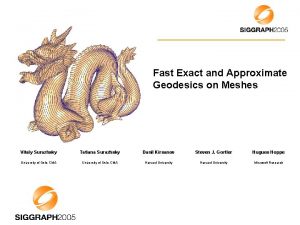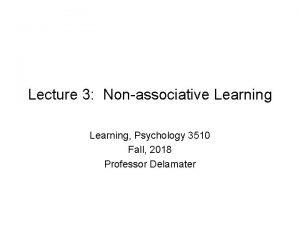Exact and Approximate Inference in Associative Hierarchical Networks

- Slides: 1

Exact and Approximate Inference in Associative Hierarchical Networks using Graph Cuts Chris 1 Oxford Unary Potentials Pushmeet Philip H. S. 2 Microsoft Unary Potential 1 Torr Research, Cambridge Cluster-based CRF (eg. Batra et al. CVPR 08) Quantization Enforces a Scale • Make an a priori decision which variables take the same label. Experimental Evaluation on MSRC dataset Higher order Potential Pairwise Potential Multi-scale Unary and Consistency Pairwise Potentials • Informative features based on aggregate properties of cluster • Enforces consistency at a single larger scale • Fixes the quantisation, may fail to separate entities or over separate. • No way to recover from a misleading clustering 2 Kohli , Formulation and inference No Quantization Used • Lacks long range interactions • Local features are less informative • Results often over smoothed 1 Ladický , Brookes University Associative Hierarchical networks and related models Standard CRF (Lafferty '01) 1 Russell , Ľubor Multi-scale Pairwise Potentials . Inference of the base layer is NP hard but good graph-cut based approximations exist (Boykov et al. '01) Approximating higher order functions is much harder. Existing approximation schemes provide an O(n) approximation (n is the size of the largest clique) or are unbounded for the robust PN and AHN (Gould et al. '09). Higher order Robust PN model (Kohli, et al. – CVPR 08) Associative Markov Network (Taskar et al '04) • Potentials enforce weak consistency over clusters • Multiple clusterings • Robust to misleading clusters • Limited to unary and pairwise potentials over variables We remove the min terms from the equation to derive a pairwise energy, Each Quantization Encourages Consistency Unary We reparameterise this energy function which allows us to perform bounded inference on the resulting energy, as on the base layer. We then project this solution back into the original space, preserving the bounds. Pairwise Higher Order Consistency PN potentials take the form of a robust majority voting Cost Pixels of different class Associative Hierarchical Networks (AHNs) (Ladicky et al. – ICCV 09) Encourages consistency at all scales Supports potentials defined over many differently sized regions Simultaneously resolves problem at all scales, minimizing inconsistency Robust to misleading segmentation N potentials reformulated as pairwise hierarchical energy Robust P New auxiliary variables take a value from the label-set or label free Unary and pairwise potentials at every quantization Multiple hierarchies of potentials N Limited to P -like associative interlayer connections This transformation from higher order to pairwise energy introduced new local minima which `trap' move making optimisations. We propose a new class of move-making algorithms which guarantee that all local minima found must be a local minima of the original higher order energy. The expressibility of common models verses AHNs PN Model Cluster-based CRF Tree Model Deep Belief Net Hierarchical Network

